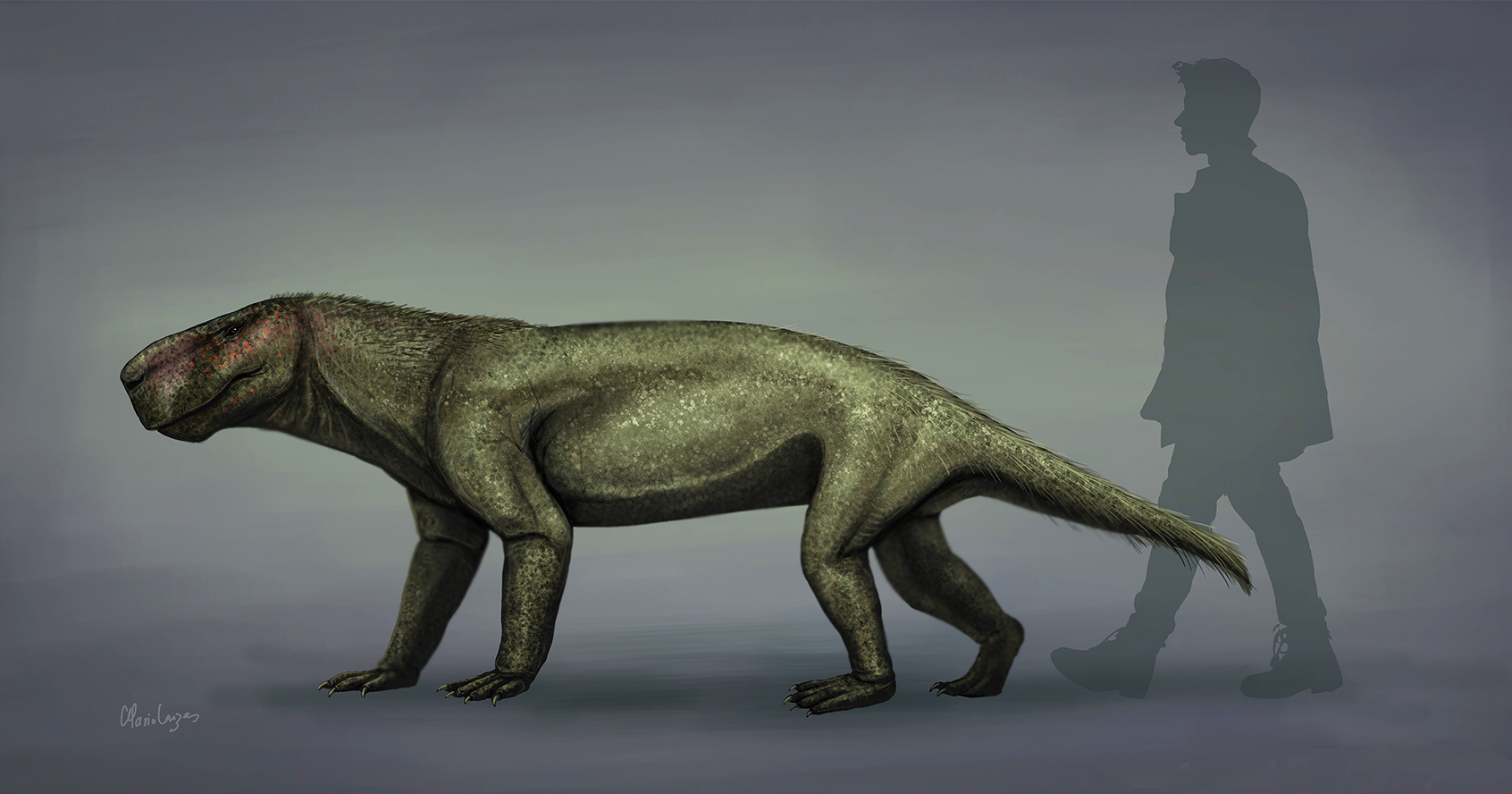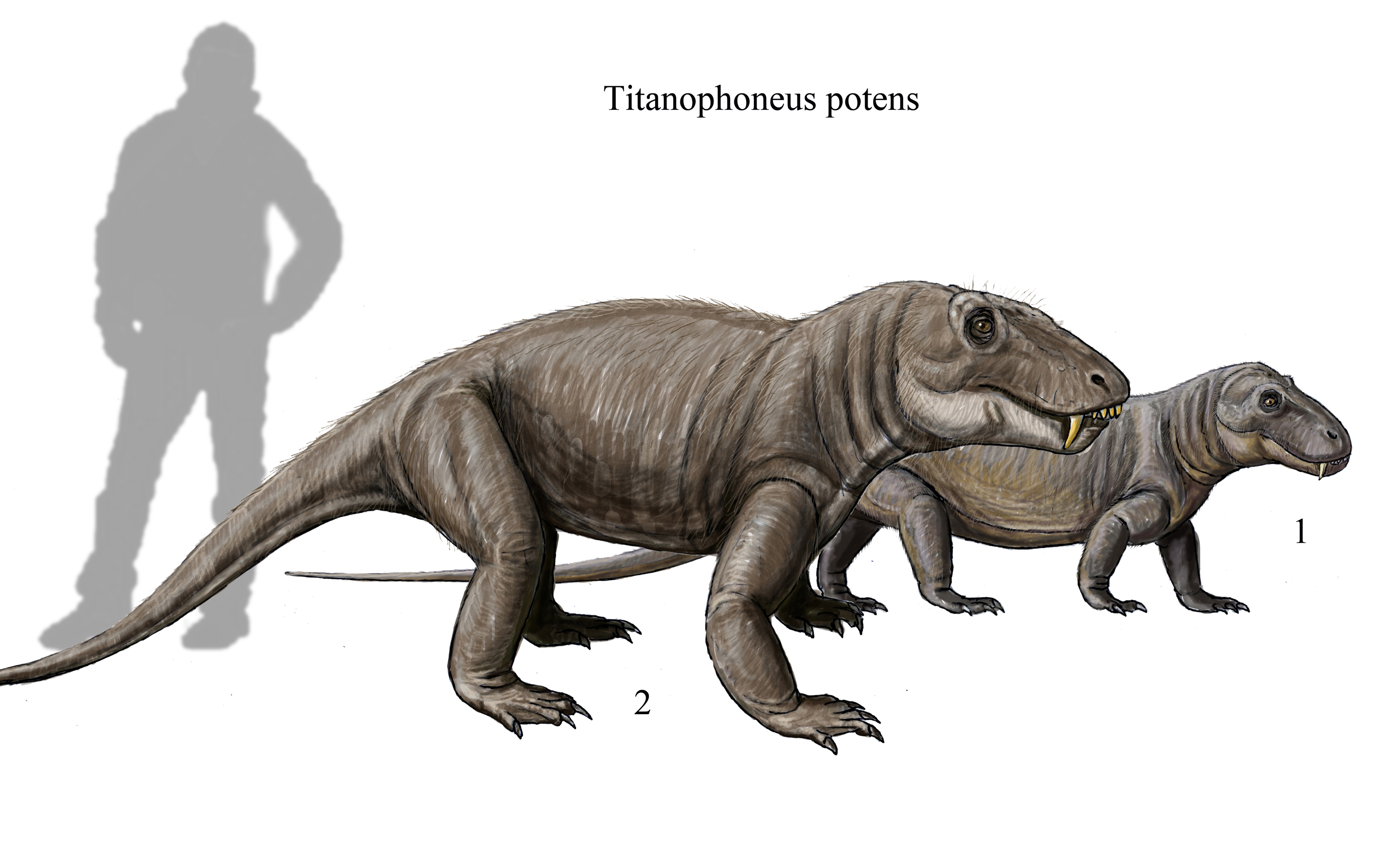|
Theriodont
The theriodonts ( clade Theriodontia) are a major group of therapsids which appeared during the Middle Permian and which includes the gorgonopsians and the eutheriodonts, itself including the therocephalians and the cynodonts. Naming In 1876, Richard Owen named a suborder Theriodontia, which he divided into the Cynodontia and the Gomphodontia. The modern clade concept was devised by James Allen Hopson. In his system, Theriodontia fall into two main groups: the Gorgonopsia and the Eutheriodontia. The latter consist of the Therocephalia and Cynodontia.J.A. Hopson. 1999. "Therapsids". ''Encyclopedia of Paleontology'' 2: 1256-1266 Evolution Theriodonts appeared at the same time as their sister group within the Neotherapsida, the Anomodontia, about 270 million years ago, in the Middle Permian. Even these early theriodonts were more mammal-like than their anomodont and dinocephalian contemporaries. Early theriodonts may have been warm-blooded. Early forms were carnivorous, b ... [...More Info...] [...Related Items...] OR: [Wikipedia] [Google] [Baidu] |
|
 |
Gorgonopsians
Gorgonopsia (from the Greek Gorgon, a mythological beast, and 'aspect') is an extinct clade of sabre-toothed therapsids from the Middle to Upper Permian roughly 265 to 252 million years ago. They are characterised by a long and narrow skull, as well as elongated upper and sometimes lower canine teeth and incisors which were likely used as slashing and stabbing weapons. Postcanine teeth are generally reduced or absent. For hunting large prey, they possibly used a bite-and-retreat tactic, ambushing and taking a debilitating bite out of the target, and following it at a safe distance before its injuries exhausted it, whereupon the gorgonopsian would grapple the animal and deliver a killing bite. They would have had an exorbitant gape, possibly in excess of 90°, without having to unhinge the jaw. They markedly increased in size as time went on, growing from small skull lengths of in the Middle Permian to bear-like proportions of up to in the Upper Permian. The latest gorgonop ... [...More Info...] [...Related Items...] OR: [Wikipedia] [Google] [Baidu] |
 |
Therapsid
Therapsida is a major group of eupelycosaurian synapsids that includes mammals, their ancestors and relatives. Many of the traits today seen as unique to mammals had their origin within early therapsids, including limbs that were oriented more underneath the body, as opposed to the sprawling posture of many reptiles and salamanders. Therapsids evolved from " pelycosaurs", specifically within the Sphenacodontia, more than 279.5 million years ago. They replaced the "pelycosaurs" as the dominant large land animals in the Middle Permian through to the Early Triassic. In the aftermath of the Permian–Triassic extinction event, therapsids declined in relative importance to the rapidly diversifying reptiles during the Middle Triassic. The therapsids include the cynodonts, the group that gave rise to mammals ( Mammaliaformes) in the Late Triassic, around 225 million years ago. Of the non-mammalian therapsids, only cynodonts survived beyond the end of the Triassic, with the only ot ... [...More Info...] [...Related Items...] OR: [Wikipedia] [Google] [Baidu] |
 |
Gorgonopsia
Gorgonopsia (from the Greek Gorgon, a mythological beast, and 'aspect') is an extinct clade of sabre-toothed therapsids from the Middle to Upper Permian roughly 265 to 252 million years ago. They are characterised by a long and narrow skull, as well as elongated upper and sometimes lower canine teeth and incisors which were likely used as slashing and stabbing weapons. Postcanine teeth are generally reduced or absent. For hunting large prey, they possibly used a bite-and-retreat tactic, ambushing and taking a debilitating bite out of the target, and following it at a safe distance before its injuries exhausted it, whereupon the gorgonopsian would grapple the animal and deliver a killing bite. They would have had an exorbitant gape, possibly in excess of 90°, without having to unhinge the jaw. They markedly increased in size as time went on, growing from small skull lengths of in the Middle Permian to bear-like proportions of up to in the Upper Permian. The latest gorgonops ... [...More Info...] [...Related Items...] OR: [Wikipedia] [Google] [Baidu] |
 |
Therocephalia
Therocephalia is an extinct suborder of eutheriodont therapsids (mammals and their close relatives) from the Permian and Triassic. The therocephalians ("beast-heads") are named after their large skulls, which, along with the structure of their teeth, suggest that they were carnivores. Like other non-mammalian synapsids, therocephalians were once described as " mammal-like reptiles". Therocephalia is the group most closely related to the cynodonts, which gave rise to the mammals. This relationship takes evidence in a variety of skeletal features. The fossils of therocephalians are numerous in the Karoo of South Africa, but have also been found in Russia, China, Tanzania, Zambia, and Antarctica. Early therocephalian fossils discovered in Middle Permian deposits of South Africa support a Gondwanan origin for the group, which seems to have spread quickly across Earth. Although almost every therocephalian lineage ended during the great Permian–Triassic extinction event, a few re ... [...More Info...] [...Related Items...] OR: [Wikipedia] [Google] [Baidu] |
 |
Neotherapsida
Therapsida is a major group of eupelycosaurian synapsids that includes mammals, their ancestors and relatives. Many of the traits today seen as unique to mammals had their origin within early therapsids, including limbs that were oriented more underneath the body, as opposed to the sprawling posture of many reptiles and salamanders. Therapsids evolved from " pelycosaurs", specifically within the Sphenacodontia, more than 279.5 million years ago. They replaced the "pelycosaurs" as the dominant large land animals in the Middle Permian through to the Early Triassic. In the aftermath of the Permian–Triassic extinction event, therapsids declined in relative importance to the rapidly diversifying reptiles during the Middle Triassic. The therapsids include the cynodonts, the group that gave rise to mammals (Mammaliaformes) in the Late Triassic, around 225 million years ago. Of the non-mammalian therapsids, only cynodonts survived beyond the end of the Triassic, with the only ... [...More Info...] [...Related Items...] OR: [Wikipedia] [Google] [Baidu] |
|
Therocephalia
Therocephalia is an extinct suborder of eutheriodont therapsids (mammals and their close relatives) from the Permian and Triassic. The therocephalians ("beast-heads") are named after their large skulls, which, along with the structure of their teeth, suggest that they were carnivores. Like other non-mammalian synapsids, therocephalians were once described as " mammal-like reptiles". Therocephalia is the group most closely related to the cynodonts, which gave rise to the mammals. This relationship takes evidence in a variety of skeletal features. The fossils of therocephalians are numerous in the Karoo of South Africa, but have also been found in Russia, China, Tanzania, Zambia, and Antarctica. Early therocephalian fossils discovered in Middle Permian deposits of South Africa support a Gondwanan origin for the group, which seems to have spread quickly across Earth. Although almost every therocephalian lineage ended during the great Permian–Triassic extinction event, a few re ... [...More Info...] [...Related Items...] OR: [Wikipedia] [Google] [Baidu] |
|
|
Cynodont
The cynodonts () ( clade Cynodontia) are a clade of eutheriodont therapsids that first appeared in the Late Permian (approximately 260 mya), and extensively diversified after the Permian–Triassic extinction event. Cynodonts had a wide variety of lifestyles, including carnivory and herbivory. Mammals are cynodonts, as are their extinct ancestors and close relatives, having evolved from advanced probainognathian cynodonts during the Late Triassic. All other cynodont lines went extinct, with the last known non-mammalian cynodont group, the Tritylodontidae, having its youngest records in the Early Cretaceous. Description Early cynodonts have many of the skeletal characteristics of mammals. The teeth were fully differentiated and the braincase bulged at the back of the head. Outside of some crown-group mammals (notably the therians), all cynodonts probably laid eggs. The temporal fenestrae were much larger than those of their ancestors, and the widening of the zygomatic ar ... [...More Info...] [...Related Items...] OR: [Wikipedia] [Google] [Baidu] |
|
|
Eutheriodont
Eutheriodontia is a clade of therapsids which appear during the Middle Permian and which includes therocephalians and cynodonts, this latter group including mammals and related forms. With the dicynodonts, they form one of two lineages of therapsids that survived the Permian extinction and which diversified again during the Triassic, before the majority of them disappeared before or during the Triassic–Jurassic extinction, except for a lineage of cynodonts that would later give rise to mammals. Classification The clade was named in 1986 by James Allen Hopson and Herbert Richard Barghusen, the name meaning the "true Theriodontia". Within Hopson's system, the Eutheriodontia are the sister group of the Gorgonopsia within the Theriodontia. A close relationship between therocephalians and cynodonts had been recognized for many years. In 2001 the Eutheriodontia were defined as the least inclusive clade including Mammalia and ''Bauria''.James A. Hopson and James W. Kitching, 2 ... [...More Info...] [...Related Items...] OR: [Wikipedia] [Google] [Baidu] |
|
|
Scylacosaurus
''Scylacosaurus'' is an extinct genus of therocephalian therapsids. References Scylacosaurids Therocephalia genera Permian synapsids Lopingian synapsids of Africa Fossil taxa described in 1903 Taxa named by Robert Broom {{paleo-therapsid-stub ... [...More Info...] [...Related Items...] OR: [Wikipedia] [Google] [Baidu] |
|
 |
Guadalupian
The Guadalupian is the second and middle series/ epoch of the Permian. The Guadalupian was preceded by the Cisuralian and followed by the Lopingian. It is named after the Guadalupe Mountains of New Mexico and Texas, and dates between 272.95 ± 0.5 – 259.1 ± 0.4 Mya. The series saw the rise of the therapsids, a minor extinction event called Olson's Extinction and a significant mass extinction called the end-Capitanian extinction event. The Guadalupian was previously known as the Middle Permian. Name and background The Guadalupian is the second and middle series or epoch of the Permian. Previously called Middle Permian, the name of this epoch is part of a revision of Permian stratigraphy for standard global correlation. The name "Guadalupian" was first proposed in the early 1900s, and approved by the International Subcommission on Permian Stratigraphy in 1996. References to the Middle Permian still exist. The Guadalupian was preceded by the Cisuralian and followed by ... [...More Info...] [...Related Items...] OR: [Wikipedia] [Google] [Baidu] |